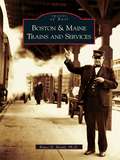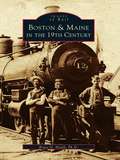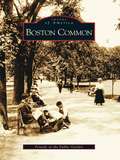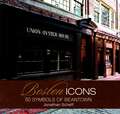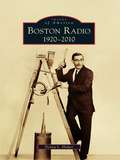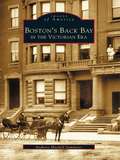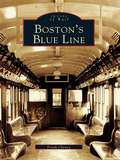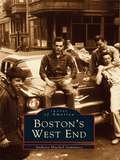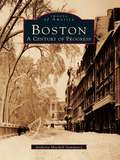- Table View
- List View
Boston & Maine Trains and Services (Images of Rail)
by Bruce D. HealdThe Boston & Maine Railroad serviced most of New England as a primary mode of transportation during the 19th and 20th centuries. The birth of this railroad spurred the growth and development of industry in New England. This heritage is captured in Boston & Maine Trains and Services, the fourth volume in Arcadia's Images of Rail series to focus on the history of this railroad. The trains and services included in this book are the Pullman passenger cars, work trains with flatcars, boxcars, circus trains, plows, stock, cabooses, as well as the Boston & Maine bus service, trucks, and air service.
Boston & Maine in the 19th Century
by Bruce D. HealdAll the romance of early railroading in northern New England pervades Boston & Maine in the 19th Century. This fascinating journey begins in the 1830s with an 8-mile line that just kept growing. By the end of the century, Boston & Maine was traveling over 2,324 miles of track. This first pictorial history of the Boston & Maine explores the heyday of an enterprising railroad. Using spectacular images, most of which have never before been published, the book takes us along scenic stretches of Massachusetts, New Hampshire, and Maine.
Boston & Maine in the 20th Century
by Bruce D. HealdAs the twentieth century dawned, the Boston & Maine Railroad Company controlled virtually all of the rail lines in New Hampshire, as well as much of the service in Maine and Massachusetts. Ultimately, the company operated more than 2,000 stations in northern New England. The train was the most important mode of travel, and the stations were the center of the community. Boston & Maine in the 20th Century continues the first pictorial history of the railroad company, entitled Boston & Maine in the 19th Century. With more than 200 rare images and historical narrative, the book details the trains and their destinations: the terminals, stations, depots, and whistle stops to which they sped. Times changed, and the railroad was passed by; however, its legacy lives on.
Boston Common (Images of America)
by Friends of the Public GardenThe nation's oldest and most venerated public park, Boston Common has belonged to the people of Boston since 1634. Throughout its history, it has been a centerpiece of civic life; the scene of executions, sermons, protests, and celebrations; and in each century, host to famous visitors from Generals Washington and Lafayette to Rev. Martin Luther King Jr. and Pope John Paul II. In Colonial times, it served as a meeting place, pasture, and military training field. Bostonians in the 19th century added treelined malls and paths and, following the Civil War, monuments and fountains. However, for all its adaptation to modern life, Boston Common remains a green retreat remindful of its storied past.
Boston Icons: 50 Symbols of Beantown (Icons)
by Jonathan ScheffProfiled here are fifty classic symbols of this extraordinary city, revealing little-known facts, longtime secrets, and historical legends.
Boston Light (Images of America)
by Sally R. Snowman James G. ThomsonOn September 14, 1716, Boston Light became the first lighthouse established in Colonial America. With many ships floundering in the treacherous waters of the Massachusetts harbor, there was a great need for navigational aid. At night and during storms, it was difficult to discern the entrance to the main shipping channel of Nantasket Roads, situated between the Brewster islands and the town of Hull. The ledges had become a graveyard for ships, resulting in great loss to human life and cargo--a deterrent to European colonization efforts. Ship captains and merchants petitioned the colonial government for a lighthouse to be erected on Little Brewster Island as a way of safe passage to the inner harbor. Three hundred years later, Boston Light continues to serve its purpose. Today, the lighthouse is protected by an ever-present Coast Guard civilian keeper and a cadre of specially trained Coast Guard Auxiliary volunteer assistant keepers.
Boston Radio: 1920–2010
by Donna L. HalperBoston's radio history begins with pioneering station 1XE/WGI, one of America's first radio stations, and includes the first station to receive a commercial license, WBZ; the first FM radio network, W1XOJ and W1XER; and one of the first news networks, the Yankee News Service. Nationally known bandleaders like Joe Rines and Jacques Renard were first heard on Boston radio, as was one of the first weathercasters, E. B. Rideout. The city has been home to a number of legendary announcers, such as Bob and Ray, Arnie Ginsburg, Dick Summer, Dale Dorman, and Charles Laquidara; talk show giants like Jerry Williams and David Brudnoy; and sports talkers like Eddie Andelman and Glenn Ordway. Many Boston radio personalities, such as Curt Gowdy, "Big Brother" Bob Emery, Don Kent, and Louise Morgan, found fame on television but first established themselves on Boston's airwaves. Since 1920, Boston radio has remained vibrant, proving that live and local stations are as important as ever.
Boston University
by Sally Ann KyddMost universities begin with a plot of land on which to build. This was not the case with Boston University. Founded originally in Newbury, Vermont, in 1839, the school moved to Concord, New Hampshire, in 1847 and finally took root in Boston in 1867. The university developed seven schools and colleges within the first few years, with more to come later. Located in the center of a vibrant city, Boston University has become the fourth largest independent university in the nation. In Boston University, follow the development of the school as it grew and changed over one hundred and sixty years. Through vintage images, learn about the Boston University School of Oratory, where the telephone was invented; the Massachusetts Agricultural College, in the heart of the city; and subterranean passages in some of the earliest buildings. Find out about the ghost that haunted one campus building and why the institution was not named Rich University for one of its founders and most generous donors.
Boston Youth Symphony Orchestras (Images of America)
by Krysten A. KechesIn 1958, under the direction of Prof. Marvin Rabin, the Boston University College of Fine Arts established a youth orchestra for junior and senior high school students from the Greater Boston area. The Boston Youth Symphony Orchestras (BYSO), formerly known as the Greater Boston Youth Symphony Orchestras, has flourished over the past 50 years, expanding beyond the original single orchestra and launching many new artistic initiatives. BYSO members have experienced countless unforgettable moments, including performances at the White House, Carnegie Hall, and renowned concert venues across the world. Today, under the musical leadership of Federico Cortese, the BYSO serves over 400 young musicians from 126 communities throughout New England. The BYSO is one of Boston's most prestigious arts organizations, with a programmatic scope that includes three full symphonic orchestras, a string orchestra, a preparatory wind ensemble, four chamber orchestras, 50 chamber music ensembles, and a nationally recognized string training program for underrepresented youth from inner-city communities. The BYSO has selected images from its extensive archives to exhibit the rich history of this organization.
Boston Youth Symphony Orchestras Revised Edition (Images of America)
by Krysten A. KechesIn 1958, under the founding music director, Prof. Marvin Rabin, the Boston University College of Fine Arts established a youth orchestra for junior and senior high school students from the Greater Boston area. The Boston Youth Symphony Orchestras (BYSO), formerly known as the Greater Boston Youth Symphony Orchestras, has flourished over the past 60 years, impacting the lives of thousands of young musicians. BYSO members have experienced countless unforgettable moments, including performances at the White House, Carnegie Hall, and renowned concert venues across the world. Today, under the musical leadership of Federico Cortese, BYSO serves 500 students from over 120 communities throughout New England. BYSO is one of Boston's most prestigious arts organizations, with a programmatic scope that includes three full symphonic orchestras, two young string training orchestras, six chamber orchestras, a preparatory wind ensemble, a chamber music program, and a nationally recognized outreach program that provides rigorous instrument instruction to students from underrepresented communities. In 2008, BYSO established an opera program that has become an integral part of the season repertoire. BYSO has selected images from its extensive archives to exhibit its rich history.
Boston in Motion (Images of America)
by Anthony M. Sammarco Frank CheneyBoston in Motion, the sequel to Trolleys under the Hub, is an intriguing collection of photographs that captures the history of transportation in and around Boston. Authors Frank Cheney and Anthony M. Sammarco trace the stories from the earliest days of public transport with the Winnissimmet Ferry to the MBTA of today. A city known for its comprehensive public transportation, Boston has hosted every type of transit known to urban America. From the ferry, the horse railway, and the omnibus to the steam railroad and, eventually, the subway and bus systems, Boston has always been at the forefront of transportation advancements. The former "El" (the Boston Elevated Railway), the Old Colony Railroad, the Red Line, and the East Boston Line dramatically changed the face of Boston in the late nineteenth and early twentieth centuries. In Boston in Motion, these advancements are presented and explored in a riveting collection of original photographs.
Boston's Back Bay in the Victorian Era
by Anthony Mitchell SammarcoThe Back Bay was one of Boston's premier residential neighborhoods between 1837 and 1901. From its quagmire beginnings and with the creation of the Boston Public Garden in the 1830s, the Back Bay was envisioned as an urbane and sophisticated streetscape of stone and brick row houses. The major center of the neighborhood became Art Square, now known as Copley Square, which was surrounded by Trinity Church, New Old South Church, Second Church of Boston, the Boston Public Library, and S.S. Pierce and Company. With images of swan boats and architectural delights, Boston's Back Bay in the Victorian Era illuminates a particularly vibrant period in this intriguing and relatively new neighborhood's past.
Boston's Blue Line
by Frank CheneyBoston's rapid-transit Blue Line covers a distance of 5.94 miles, a twenty-three-minute commute that begins at Bowdoin station in downtown Boston, travels under the harbor, passes Revere Beach, and stops at Wonderland. Today's commuters might be surprised to learn that the line they are riding was once operated by trolley cars and narrow-gauge steam-powered commuter trains, for it was not until 1904 that the East Boston Tunnel under the harbor was completed. By 1917, the number of people riding the Blue Line had climbed to twenty-five thousand a day. Although significant advances had been made to accommodate high-volume commuter traffic, rush-hour congestion at downtown stations remained a problem. In the 1920s, with ridership exceeding forty-two thousand people a day, the Boston Elevated Railway and the Boston Transit Commission agreed to convert the tunnel to a rapid-transit operation with a transfer station at Maverick Square. Further expansion occurred in the 1950s, when the Blue Line was extended to Orient Heights, Suffolk Downs, and Revere Beach.
Boston's Financial District
by Anthony Mitchell SammarcoBoston's financial district is considered the heart of New England's banking and finance. It is a veritable overlay of sleek modern office buildings and elegant high-rise structures of the early twentieth century. In the center of this contemporary skyline is evidence of the financial district's long history. Boston's first skyscraper, the Boston Custom House tower, stands high from where it was built in 1915 on top of the original 1849 custom house building.Boston's Financial District chronicles the steady change from a romantic neighborhood to numerous banking and business houses. It was originally known as Old South End and was a residential site of elegant mansions designed by Charles Bulfinch and located on tree-lined squares and streets that emulated the aristocratic boroughs of London. The photographs in Boston's Financial District show evidence of the destruction wreaked by the Great Boston Fire of 1872 and the rebuilding of Boston's center of commerce. With its well-known banks and businesses, the financial district has witnessed some of the most monumental and influential historical changes in the city of Boston.
Boston's Immigrants: 1840-1925
by Michael Price Anthony Mitchell SammarcoBoston is a city rich in the history of residents from all walks of life, every country and every ethnicity imaginable. From 1840 to 1925, Boston's diversity created a city with a thriving nexus of people who wove together a community that reflected their own unique heritage. In this lavishly illustrated book with over 200 thought-provoking and evocative photographs, Anthony Mitchell Sammarco and Michael Price have created an important book chronicling the determination, strength, and often manifold successes of immigrants who arrived in Boston. From the mid-nineteenth century when Boston's burgeoning population included one out of every three as being foreign born, the immigrants' arrival at the East Boston docks increased greatly between 1840 and 1925, where they were to pass into the New World, and a new life. In chapters that deal with the immigrants before their arrival, their first perceptions, to where they went, worked, and played, this book outlines the ancestors of many present-day Bostonians in the evolving process of Americanization.
Boston's North End
by Anthony Mitchell SammarcoThe streets of Boston's North End, some laid out in the seventeenth century, exude a rich history that has included every generation of immigrants to Boston since 1630. An active port, the neighborhood of the North End also included churches of every denomination, historic homes, and early commercial concerns. Immigrants from Russia, Ireland, Germany, Italy, and most other European countries settled in the North End and contributed to itsdevelopment over the years. Today, most visitors to Boston tour the North End and see the Paul Revere House and the famous Old North Church. On the weekends, shoppers visit the bustling Haymarket and attend feasts and festivals amidst the appetizing ambiance of restaurant row. This thriving, lively area of town is an alluring meeting place forresidents and tourists alike.
Boston's North End
by Anthony Mitchell Sammarco Charlie RosenbergSince Boston's settlement in 1630, the North End has developed from a neighborhood of residences and artisan shops. Known for the nationally important Paul Revere House, which is the oldest standing building in Boston, and the Old North Church, the North End is a destination for tourists.
Boston's Orange Line
by Andrew Elder Jeremy C. FoxThe story of the Orange Line is the story of Boston: always in flux but trailed by its long history. Since 1901, this rail line's configuration has evolved in response to changes in the city, society, and technology. Hazardous sections have been eliminated, ownership has transitioned from private to public, and the line has been rerouted to serve growing suburbs and to use land cleared for the failed Inner Belt. Both its northern terminus, which shifted from Everett to Malden, and the southern route, realigned from Washington Street to the Southwest Corridor, have seen dramatic transformations that have in turn changed riders' lives. Today, the line's 10 miles of track curve through many Greater Boston communities, serving thousands along the way.
Boston's Red Line: Bridging the Charles from Alewife to Braintree
by Frank CheneyWhen the Boston Elevated Railway Company broke ground for the Cambridge Subway in May 1909, its intention was to provide the cities of Boston and Cambridge with the finest and most efficient rapid-transit system of the time. Other cities, such as New York and Philadelphia, paid close attention, adopting many of the Cambridge Subway's revolutionary design features. The subway became known as the Red Line and eventually extended from Cambridge across the Charles River through Boston, serving Dorchester, Braintree, and Mattapan.Boston's Red Line: Bridging the Charles from Alewife to Braintree details one of Boston's oldest and busiest subway lines. This nostalgic collection of vintage photographs documents the line's construction and its engineers and leaders, such as Maj. Gen. William A. Bancroft, mayor of Cambridge and president of the Boston Elevated Railway Company. In these pages, watch as crews break ground in Harvard and Andrew Squares and see the 1929 trolleys that replaced Mattapan's commuter train service. Through exciting, historic photographs, Boston's Red Line: Bridging the Charles from Alewife to Braintree tells the fascinating story of how the Crimson City's subway became the modern Red Line, taking passengers beneath the streets of Boston to landmarks such as Harvard Square, Massachusetts General Hospital, historic Park Street, and the Longfellow Bridge.
Boston's South End
by Anthony Mitchell SammarcoOriginally a narrow, barren strip of land known as the Neck, Boston's South End grew from a lonely sentry post and execution grounds to what is today the largest Victorian neighborhood in the United States. With the filling of the South Cove in the 1830s, the area became one of the greatest planned residential districts of its time, a heritage preserved in unique architectural features such as red brick swell bay facades, elaborate balusters, and fanciful porches.
Boston's Theater District (Images of America)
by Dale StinchcombDowntown Boston once thrived as a dazzling bohemia of burlesque halls, movie palaces, dime museums, and regal stages. By 1915, more than 20 theaters crowded along a quarter-mile stretch of lower Washington Street. The theater district gave birth to vaudeville and incubated some of America's most darling musicals and daring new dramas en route to Broadway. Theatergoers flocked to Tremont and Boylston Streets to watch the latest tryouts. Some productions flopped; others, like Oklahoma! and Paul Robeson's Othello, were runaway hits. Still others earned the coveted seal of disapproval, "Banned in Boston," from zealous city censors. Overrun by seedy venues in the 1970s, the Combat Zone, as it came to be known, seemed to justify old Puritan fears that the stage would corrupt public morals. Only in recent years has the district rebounded through careful restoration of storied playhouses like the Boston Opera House, the Majestic, and the Colonial--grand vestiges of a booming cultural corridor still vibrant today.
Boston's West End
by Anthony Mitchell SammarcoWithin these pages, author Anthony Mitchell Sammarcobrings to life the history of Boston's West End--thearea of the city bound by the Charles River and Storrow Drive as well as North Station, City Hall Plaza, and Myrtle Street. Once a thriving, energetic, and diverse neighborhood, the West End was slated for complete removal following World War II. In over 200 marvelous photographs, this collection recaptures fond memories for former residents and shows newcomers the history of the West End. Now the site of luxury, high-rise apartment buildings, condominiums, and stores, Boston's West End was once the site of many Bulfinch-designed townhouses owned by prominent families. In later years, the neighborhood was home to a diverse ethnic and religious community of families who arrived in Boston from all parts of the world. Today,three decades after the West End was virtually leveled, it is still fondly remembered by many who once called it home.
Boston, New York (Images of America)
by Sherrie L. PlutaIn 1803, when Charles Johnson and his brother Oliver left their family in Cayuga County to move west to the Boston Valley, they brought their pioneer spirit and strength with them to an untouched wilderness. The valley was a serene meadow, and the hills surrounding it were perfect for farming and raising cattle and sheep. As others came with their families, the wilderness became tame, and the town grew as the community built harness shops, cheese factories, sawmills, and schools. In the years that followed, the town experienced both tragic and joyous events. From John Love's murder in 1824, through a typhoid epidemic in 1840, the birth of a world-famous opera singer in 1868, the construction in 1903 of the Buffalo and Susquehanna Railroad through town, the genesis of the Boston Telephone Company in 1904, the emergence of the town's many churches, and the building of three fire companies, Boston shaped itself into the town it is today.
Boston: A Century of Progress
by Anthony Mitchell SammarcoOn March 4, 1822, the townsfolk of Boston voted to incorporate their town as the City of Boston. A great change had just taken place, but even greater changes were to come during the ensuing century, as Boston's population grew from 50,000 to 750,000 by 1922 and as it developed from a colonial town into the "Hub of the Universe." Boston: A Century of Progress brings to life one hundred amazing years, from 1822 to 1922. More than two hundred fascinating images are combined with compelling text to take us on a mesmerizing journey back into our past and bring us face to face with the people, places, and events which shaped Boston's destiny. Through these images we explore neighborhoods ranging from the North End to Downtown, Beacon Hill, Back Bay, and Fenway. We see landmarks and buildings both familiar and long-gone - schools, churches, mansions, stores, tenements, and parks. We meet not only the movers and shakers but also the ordinary people who lived, worked, and played in Victorian Boston, including the vast numbers of immigrants (by 1850, half of all Bostonians were foreign-born).
Botanical Beauty: 80 Essential Recipes for Natural Spa Products
by Aubre AndrusSoak, scrub, and soothe your way to relaxation with simple homemade spa recipes from award-winning author Aubre Andrus. Using some of nature’s best ingredients, such as beeswax, sugar, coconut oil, shea butter, avocado, sea salt, essential oils, and more, craft everything from a Cooling Peppermint Hand Cream to a Vanilla Honey Body Scrub. Make practical products, like your own all-natural Bugs-Be-Gone Insect Repellent, Minty Homemade Toothpaste, and Natural Shaving Cream. Or pamper yourself after a long day with a Re-energizing Tub Tea, Lovely Lavender Bath Salts, and a Deep Conditioning Treatment. Nourish your body from head to toe with these organic, handmade recipes and crafts, or package them as a gift to share a fresh, fun spa experience.
